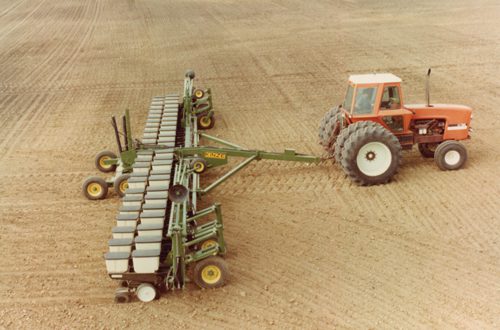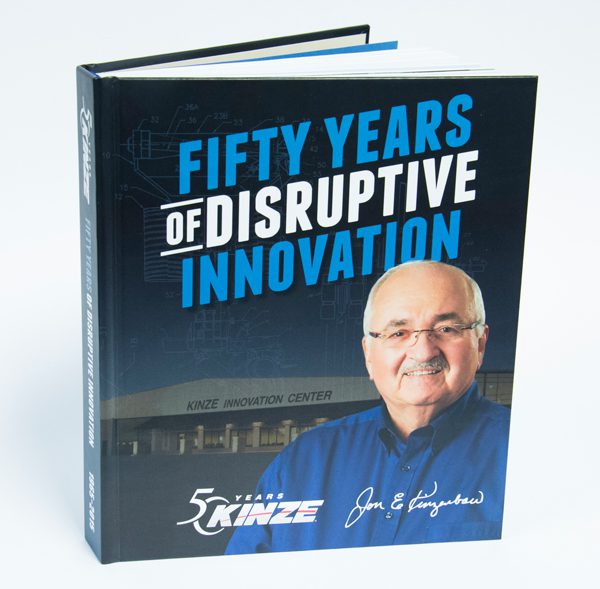Forty years ago, Kinze Manufacturing was just a small farm equipment startup near Williamsburg, Iowa. After developing several innovative products, the company was starting to attract the attention of farmers looking for ways to improve their farming efficiency. However, Kinze was also drawing the attention of the industry-giant, John Deere.
The following is the second installment of a five-part series describing Jon Kinzenbaw’s early battles with John Deere – both in the field and in the courtroom. What started out as suit over row unit availability, eventually ended in a ruling that forever changed Kinzenbaw’s young company – and the ag equipment industry as a whole!
This excerpt is from the book “Fifty Years of Disruptive Innovation” and is told in Jon’s own words. If you missed part one, click here to catch up on this blog series.
A Chance Worth Taking
In 1979, I had borrowed $3.5 million for the production season. We paid most of it back, but couldn’t pay it all back because of the 150 frames that could not be completed due to the row unit shortage. I went to my banker, John Mangold, at Merchant’s Bank in Cedar Rapids, Iowa, and asked him for another $3.5 million to finance the planter frame production for 1980. Then I announced we were going to tool up and build our own row unit and needed another $1 million for the tooling, dies, jigs and fixtures. In addition, I needed another $3.5 million to pay for the cost of building the new row unit. So, in total, I wanted to borrow well over $8 million with no co-signer or collateral other than the company and a small number of personal assets.
To thicken the plot, if we failed in our attempt to build our own row unit, it could bankrupt us, and if John Deere prevailed in its lawsuit, that could also put us out of business. I remember telling Mangold, “If I can get these row units built, I think I can make this happen, but by the way, we will most likely be in a lawsuit with John Deere. I really have no choice. Without any row units, I will be out of business.” Failing at either one of these would shut down the business and cause me to default on the loans. Mangold went to his board of directors and a week and a half later, called me back. He said, “Go for it, we are behind you all the way!”
Years later, I asked Mangold how in the world he justified sticking his neck out for me. Had we failed, it would have likely cost him his position at the bank. He simply grinned and said, “Jon, a banker gets his kicks out of being a part of something like this and seeing a company like yours prevail.” From 1974 until the late 1980s, when Mangold passed away, I had borrowed many millions of dollars, but I doubt I was in the bank more than four times. Mangold always came to the shop to do business because he enjoyed walking through the factory and feeling like he was a part of it. He was a no-nonsense kind of guy, and was willing to take a risk on me. I felt God’s hand in this, because what he and his bank did was totally unheard of in the financial world.

My attorney, Jim Hill, suggested that I copy the Deere row unit in its entirety. He said, “Its patents are invalid and not enforceable due to inequitable conduct, so just copy it, every nut and bolt. Make it exactly the same and find someone with the expertise to help you do it.”
So I went to Ron Peck, the general manager of Die-Matic in Montezuma, Iowa, which made automotive parts for Detroit, to help me manufacture the row unit. Peck took the Deere row unit apart in his home and laid out all the pieces on the carpet in his basement. He brought in managers from each of Die-Matic’s five locations and distributed work to all of them. It took 14 months from the time we got Deere’s “shortage” letter to get the row unit ready for the National Farm Machinery Show in Louisville, Kentucky, in February 1980. It cost us $238 in components plus labor to build our row unit, while Deere was selling its row unit for $1200 list. The only thing we changed was the color — we painted our row units black since we didn’t need them to be green for them to sell.
Prior to showing the Kinze row unit at NFMS, we filed a lawsuit against Deere for its breach of agreement from the 1977 lawsuit. Deere saw our row unit at NFMS and shortly thereafter filed a countersuit against us for patent infringement. A short time later, because my row unit was not yet publicly available, a smooth talking dealer from Illinois showed up at my shop and convinced me he needed one of my row units right away to show at his upcoming open house. Since he was a dealer selling Kinze rear-fold planters, I gave him one and he put it in the trunk of his car. What I didn’t know until later, when it was disclosed during the court battle, was that he took it directly to Deere in Moline.
In late February, I learned that my supplier making the fiberglass row unit hoppers in Grinnell was not able to produce them, which was a very serious situation. We could not sell planters without these hoppers and were only about eight weeks away from planting season. I learned that Molded Fiber Glass Company (MFG), owned by Bob Morrison in Ashtabula, Ohio, made all the hoppers for Deere and International Harvester. This was a very specialized business and a sole supplier of these components for both competitors. MFG also made cab parts, fenders, doors, etc. for semi-trucks.
I flew out to Ohio to visit MFG and see if it could build my hoppers. Morrison informed me that Deere owned the tooling, which cost $180,000 and took six months to build, and that he couldn’t use its tooling for my project. However, he had a new process that he had been using for truck doors that he said we could try. It included an aluminum mold that was quicker and was used for shorter batches. Morrison instructed me to go down the road to the John Deere dealership and buy an insecticide hopper and seed hopper and then visit the nearby pattern maker. I did, and the pattern maker and I discussed a modified design for which he would make a reverse wooden pattern then MFG would use that pattern to make the temporary tooling for my hoppers. The pattern maker told me it would take him about a week to create the wooden patterns.
I returned to MFG and Morrison took me across the street to see his new warehouse. I will never forget the rows and rows of John Deere seed and insecticide hoppers stacked face down on pallets. As I quickly counted the number of rows while asking him how many were on a pallet, I estimated there to be a total of about 40,000 of each type of hopper. Morrison asked me why I didn’t buy these hoppers from John Deere and I told him that is what I tried to do. I explained the situation to him and he said, “No wonder we have our warehouses full of these undelivered hoppers. They are cutting production back so they don’t have row units.”
Before leaving at the end of that long day, I gave Morrison a $50,000 down payment check to produce my seed hoppers and insecticide hoppers. By the time I got home from the airport that night, there was a message at the office from his secretary asking me to call him back. I did and he told me that Deere contacted his sales representative that day and told him that a guy from Iowa might be coming out to visit him and he should not do anything to jeopardize their business relationship. So I gave Morrison the phone number for Jim Hill, and asked him to talk to Jim and get a better understanding of the situation. He did, then called me back and said, “Jon, you and I agreed to do business and you wrote me a check. No one, including John Deere, is going to tell me who I can do business with.”
Amazingly, a few months later in mid-April, we received the completed hoppers. In the meantime, I had been shipping planters to farmers without hoppers, promising I would send them in a few weeks, and no one complained. Later, I asked several farmers why they paid for and took delivery of planters that were useless without the hoppers. Their answers were the same: They were all so tired of Deere creating shortages of tractors and other products to drive up prices, and they were more than happy to support me. For the 1980 season we ended up successfully building 350 planters.
The Story Continues

Stay tuned for the next installment of the John Deere v. Kinze series to come out in the next couple of weeks.
Can’t wait for the rest of the story? The remainder of this story and many more are told in the book “Fifty Years of Disruptive Innovation”, which can be purchased on Amazon or in the Kinze Store.
